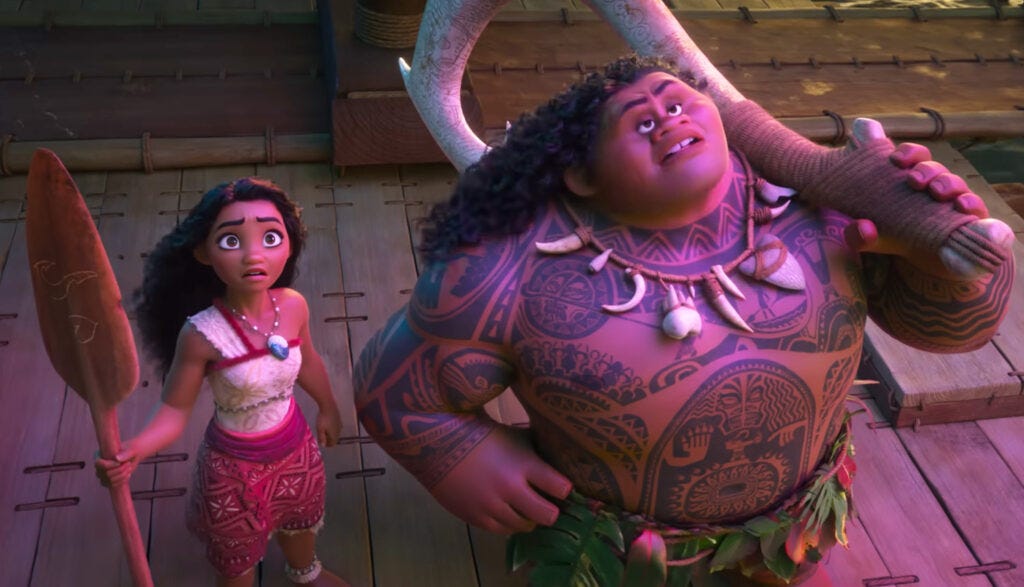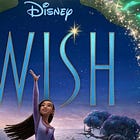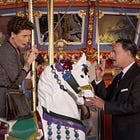Moana 2
Heavily referential of its 2016 predecessor, this sequel folds its eponymous hero’s adventures into a reimagined Pacific mythology and expanding Disney canon.

Please support my work by becoming a free or a paid subscriber to the newsletter. Paid subscribers can access my full archive of posts at any time, and are vital to me being able to continue producing and expanding this newsletter.
This post is part of the regular ‘One Take’ series analysing the politics of a film currently showing at the cinemas.
Content warning: Death and bereavement.
Note: Given that, at time of writing, Moana 2 is still showing in UK cinemas, this analysis only lays out as much of the film’s scenario as is necessary so as to avoid spoilers. It is therefore suitable to be read either before or after watching the film, while hopefully still enriching the viewer’s appreciation of it either way.
Moana 2 follows some years after the original film, in which its eponymous protagonist, a young girl from the Polynesian island village of Motunui, was selected by the ocean to restore the heart of Te Fiti, stolen from the goddess by the shapeshifting demigod Maui. This led to a gradually expanding ecological disaster, eventually blighting her island’s food supply, prompting Moana to defy her village chief father (with her dying grandmother’s encouragement) and sail out to sea to find Maui. Through a series of adventures together (along with her stowaway pet rooster Heihei), overcoming unspeaking pirate coconuts the Kakamora, giant crab Tamatoa, and lava monster Te Kā, Moana eventually earned her sceptical companion’s admiration and friendship, and returned Te Fiti’s heart, bringing serenity and balance back to the maritime ecosphere, before returning home a hero.
In the sequel, the now older adolescent Moana (voiced by Auliʻi Cravalho) still lives on Motunui with father Tui (Temuera Morrison), mother Sina (Nicole Scherzinger), and now little sister Simea (Khaleesi Lambert-Tsuda), but regularly voyages to other nearby islands. On one trip, she finds a pot fragment, pointing to the existence of other peoples. Upon returning, she receives a vision of her ancestor Tautai Vasa (Gerald Ramsey), explaining that the storm god, Kalo (Tofiga Fepulea'i) once sank the island of legendary island of Motufetu, which had linked the peoples of other different islands, out of his hatred for mortals, and that if it is not raised once more, the people of Montunui and other islands will die.
Moana therefore sets out to sea again, this time with a crew comprised of the young historian Moni (Hualālai Chung), engineer Lori (Rose Matafeo), and the bad-tempered elderly farmer Kele (David Fane), as well as Heihei and Moana’s pet pig, Pua. They hope to once again secure Maui’s help, only to instead encounter Moana’s old foes, the Kakamora. Unbeknownst to them, Maui (Dwayne Johnson) has his own reasons to seek out Nalo, but must also negotiate his own potential obstacle, in the form of Nalo’s mischievous henchwoman, Matangi (Awhimai Fraser).
Sequels and referentiality
Moana 2 fits within a broader recent tendency by Disney towards self-referentiality as it approached and passed its centenary. This has included live actions remakes such as Beauty and the Beast (2017), Aladdin (2019), and The Lion King (2019), as well as broader re-envisioning of studio lore in films as diverse as Saving Mr Banks (2013) and Wish (2023). Beyond Pixar, it had been less inclined to build consistently cinematic franchises, making lower budget sequels to recent and older animated films from the 1990s onwards, but predominantly releasing them direct-to-video, as well as spin-off TV series. Frozen II (2019) bucked this trend, a major commercial and critical box office hit, but then Frozen (2013) had been a success several orders greater than other recent animated Disney films.
Having initially been slated as a TV series before being belatedly converted into a film for cinematic release, Moana 2 falls somewhere between those poles. It presents a world that is largely the one built in its predecessor with little supplementation, save that it is decidedly post- the events of that film, with the tension between Moana and her father resolved, the people of Motunui’s reluctance to leave the island overcome.
Opportunities are regularly taken to reiterate plot points from the first film; this is hardly unusual – think, for example, of Olaf the snowman’s recapitulation of the plot of Frozen in Frozen II – but Moana 2 also pretty much re-treads the same water as its predecessor, beat by beat: Moana’s vision alerting her to a crisis and its solution; the encounter with the Kakamura; the swapping in of Nalo for Te Kā, and Matangi for Tamatoa; a reversal of Moana’s inspirational speech to Maui. The songs too consciously nod at counterparts from Moana, such as ‘Beyond’ aping ‘How Far I’ll Go’, or ‘Can I Get a Chee Hoo?’ doing likewise with ‘You’re Welcome’.
Gods, ancestors, and cosmology
The world presented in Moana was one without clear demarcations between the temporal and spiritual, between history and religion. The people of Motunui were the victims of a creeping ecological disaster that was divine (rather than human) in origin, but that they could redress if they would seize the opportunity to do so. Moana, anointed for this role as a small child, could rescue and recruit a demigod in order to rectify his original sin and reattain cosmological balance. The passage of time between that earlier point of divine origin and a human present was apparently vast. Yet it was unsettled by Moana’s grandmother, Tala (Rachel House), as interpreter of the past and prophesier of the future, before the full restoration of the unity of past and present through Moana’s actions. Human time in Moana is measured in ancestors, whose manifestation to their descendants after death is a further marker of continuity.
In Moana 2, the events of the first film are now folded into that time of divine activity and historical legend. Moni has succeeded Tala as the community’s historian, incorporating Moana’s adventures with Maui into those stories, illustrated, as they were in the first film, with monochrome stencilled fabric prints. This is a society distinctly post-redemption, in re-communication with that which is more than human: gods and demigods, monsters, and ancestral spirits. It is also one in which a new original wrongdoing, again that was divine rather than human in its perpetration, this time born of malice rather than hubris, necessitating another extraordinary act by the film’s eponymous hero to resolve the crisis and sustain her people. This time, at her father’s urging, her mission is a more collective endeavour, and yet Moana remains somewhere between the human and the transcendental: a future chief, a wayfinder, a heroic representative of Montunui, but also an historical-religious figure, rewriting the cosmological record.
There is an intrinsic connection between Moana 2’s evocation of a world in which the legendary and the everyday map onto each other, and the film’s aforementioned referentiallity, its consciousness of being part of a cinematic franchise and canon. The story is being inscribed both into a fictionalised Pasifika and Disney lore as it proceeds, and the parallels are often explicitly drawn. Moni’s adulation for Maui, for example, straddles a reverence for a figure of religious-historical significance and a fan’s almost cloying excitement about a celebrity in the world as is. Likewise, Moana functions both as a legendary, almost (if embarrassedly) messianic figure, and as an object of fandom both within Montinui and beyond the realm of the film itself.
An ocean world and its peoples
The vision of impending ecological disaster in the Pacific world, caused by external actors, is a potently symbolic one given the catastrophic environmental impacts of Western colonialism and militarism and climate change caused by far more industrialised nations. The fate of Motufetu, whose submersion has resulted in the unnatural dispersal and dissipation of Pasifika societies, echoes the contemporary threat of rising sea levels and likely depopulation faced by island states such as Tuvalu. Yet as a knowing joke by Maui about smartphones implies, the events depicted in Moana 2 occur millennia before our current moment. This is a premodern world, and crucially pre-encounter with European peoples.
Setting Moana and Moana 2 instead in the period of the original Austronesian settlement of the Pacific islands, aside from offering representation to the history of Pasifika peoples, also means that voyaging and exploration can be presented as exciting but without the implications of domination and exploitation in the European ‘Age of Discovery’.1 Another metaphor of colonisation present in the first film was the notion that in accepting a sedentary lifestyle on their island, offering – as per the lyrics of the song ‘Where You Are’ – all that was necessary for flourishing and contentment, the people of Montinui had ‘forgotten who we are’, as Tala lamented.
Moana’s, and subsequently her fellow islanders’, re-embrace of maritime travel comprised a re-finding of those authentic ways – a logic that persists in Moana 2: ocean-faring and human contact are tantamount to survival itself, a remembering of lost connections spurred by the spirits of their ancestors themselves. Moni’s succession from Tala as the village historian, Loto’s restless engineering spirit, and the elder Kele’s horticultural expertise (adapted for a life on the waves) all reinforce a unity between honouring tradition and pursuing progress.
This bears relation to what Holger Droessler has termed – with regard to Samoa – an ‘Oceanian Globality’, a response to the imperial powers’ vision and enactment of globalisation, whereby Samoans took their own opportunities to travel and work and forge connections with other colonised peoples. It was rooted in the notion that the expansive ocean did not separate them from, but rather connected them to, a wider world.2 There is an element of this conception to the voice casting of Moana 2, like that of its predecessor, which draws upon actors of indigenous Hawai’ian, Samoan, and Māori descent, the expression of a common Polynesian identity through working on an American-made film. It is also integral to the film’s promise of reunion of different peoples of the Pacific by means of ocean travel, in spite of malicious external efforts to keep them apart.
If you’ve enjoyed this post, you can also show your appreciation by sharing it more widely, recommending the newsletter to a friend, and if you’d like, by buying me a coffee.
You might also enjoy these posts from the Academic Bubble archive:
See Stuart Bedford, ‘Austronesian Colonization of the Pacific Islands, 1200 BCE–1250 CE’, in Ryan Tucker Jones and Matt K. Matsuda (eds.), The Cambridge History of the Pacific Ocean: Volume I: The Pacific Ocean to 1800 (Cambridge: Cambridge University Press, 2022), pp. 434–456.
Holger Droessler, Coconut Colonialism: Workers and the Globalization of Samoa (Cambridge, MA: Harvard University Press, 2022).




